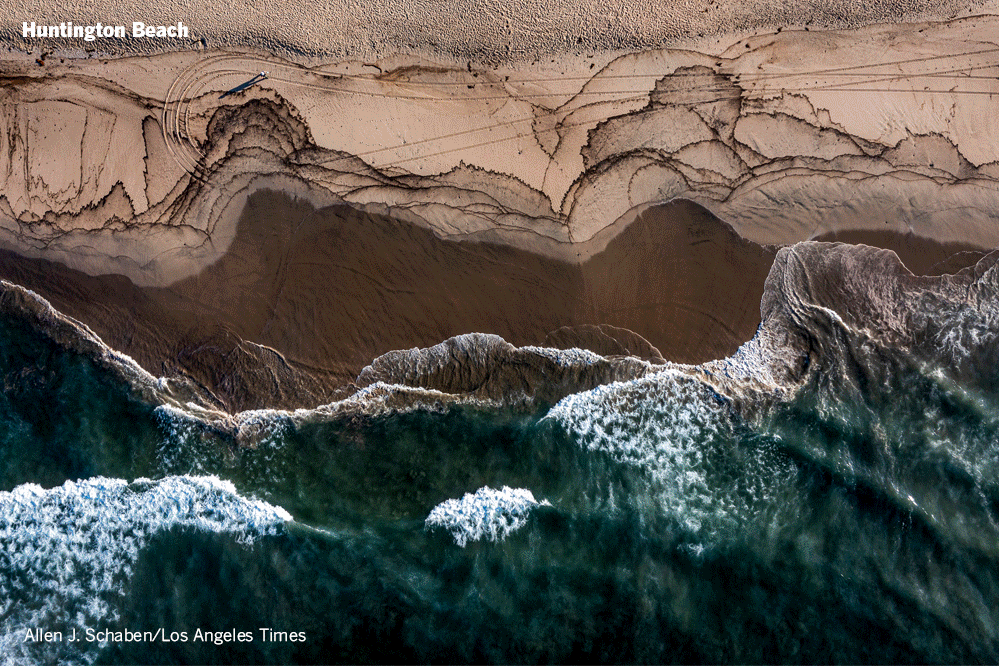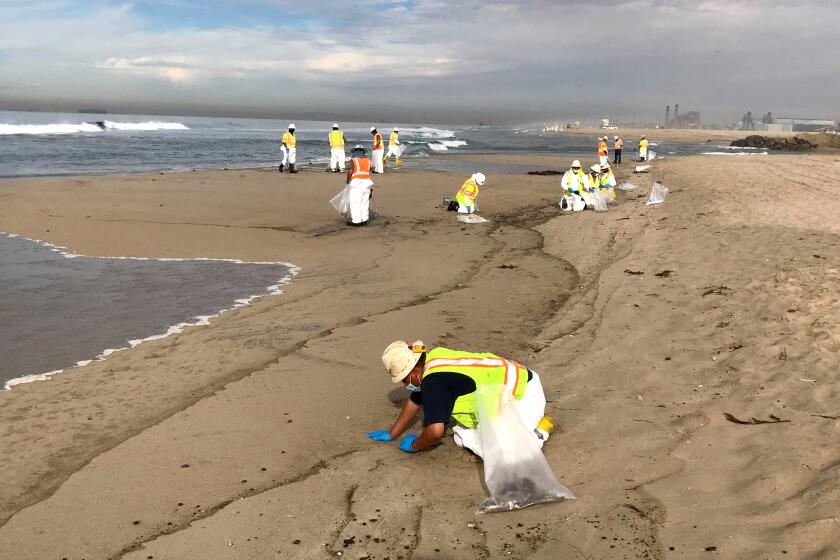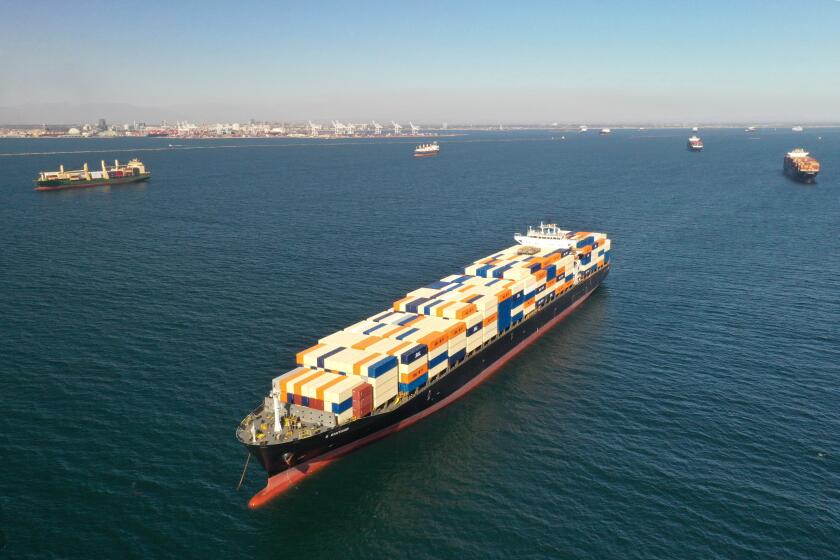FBI joins investigation of Orange County oil spill as Coast Guard drastically reduces size estimate

The FBI has joined the investigation into the oil spill off the coast of Orange County, which the Coast Guard said was much smaller than earlier estimates, officials said Thursday.
Multiple state and federal investigative agencies are already examining whether any criminal violations occurred with the pipeline leak, which spilled into the waters off Huntington Beach nearly two weeks ago. Officials have not yet served any search warrants in connection with the investigation, Laura Eimiller, an FBI spokeswoman, said.
Officials initially estimated as much as 144,000 gallons of oil was spilled into the ocean but later revised that number to between 24,696 and 131,000 gallons. On Thursday, U.S. Coast Guard Lt Cmdr. Scott Carr said the agency is confident the number of gallons leaked is around 25,000, based on scientific data and years of handling such spills.
The Coast Guard’s criminal investigative unit, the California attorney general’s office and the Orange County district attorney’s office are all already conducting a criminal inquiry.
The FBI is now assisting with the criminal investigation, which among other things is examining whether there was a negligent discharge of oil into navigable waters. An oil sheen was first spotted the evening of Oct. 2 by a vessel 4½ miles off Huntington Beach and then detected by the National Oceanic and Atmospheric Administration.
A federal agency that oversees pipelines has already initiated an inquiry and requested documentation from Amplify Energy, the parent company of Beta Offshore, which operates the pipeline linked to platforms off the coast.
But so far, no investigative agency has acknowledged serving search warrants or subpoenas on the oil company or any shipping company. At least two vessels that were near the pipeline Oct. 2 have been boarded by Coast Guard investigators to determine whether they could have been involved. Both have since been cleared.
Officials raised concerns in the 1970s about plans for oil platforms off Orange County.
In addition, the Coast Guard began an investigation with assistance from the National Transportation Safety Board. The agencies believe an anchor drag from a large vessel broke the pipe’s concrete casing sometime in the last year and shifted the pipe more than 100 feet. The previous damage eventually caused a 13-inch crack to emerge in the pipeline.
Sources familiar with details of multiple investigations but not authorized to publicly discuss specifics said that evidence so far suggests the oil leak was not long-term despite bowing of the pipeline that could be as much as a year old.
Amplify Energy Chief Executive Martyn Willsher has been evasive about the crucial hours before the company formally reported finding oil in the water Oct. 3, offering information that conflicts with state and federal records and providing vague responses to questions at news conferences.
For Amplify, the first sign of trouble seems to have occurred at 2:30 a.m. Oct. 3, when control room employees received a low-pressure alarm on the 15-mile pipeline that funnels crude oil to land, according to a letter from the Pipeline and Hazardous Materials Safety Administration, which oversees oil pipelines. The pipeline was operating at about 30% of its maximum pressure, the agency said.
An Oct. 4 letter that instructed Amplify not to restart the San Pedro Bay pipeline until it was proved safe says that the alarm indicated “a possible failure” and that the operating company shut down the pipeline 3½ hours later, at 6:01 a.m. The 2:30 alert also appears as an incident time on both federal and state reports from the company’s risk management firm’s call to federal authorities. Willsher has said the company first saw oil in the water at 8:09 a.m. Oct. 3 and reported it within the hour.
A major oil spill off the coast of Huntington Beach, Calif., washed up on nearby Orange County beaches, killing fish and birds and threatening local wetlands.
Darius Kirkwood, a spokesman for the federal pipeline oversight agency, said in a statement that the pipeline owner must keep the line closed until a comprehensive review of records is completed and a determination of whether deteriorating conditions exist elsewhere on the line is made.
In addition to the rig operator’s actions, investigators are looking into whether unprecedented gridlock at the ports of Los Angeles and Long Beach played a role in the spill.
The leak has escalated the national focus on the pandemic-induced logjam of cargo vessels outside the ports, which handle one-third of the nation’s imports, leading President Biden to broker a deal this week for the facilities to operate 24 hours a day.
Investigators are looking into possible issues with the way ships are anchoring or drifting off the coast as they wait to dock.
A global supply chain breakdown has resulted in gridlock at the ports of Los Angeles and Long Beach and beyond.
The offshore traffic jams have forced ships to wait well beyond their usual times, dropping their enormous anchors near oil platforms and an undersea infrastructure of oil lines.
The Coast Guard and NTSB are focusing on a period early this year when heavy winds may have pushed large vessels over the pipeline. They are examining which vessels were in the vicinity Jan. 24 and 25 and are gathering data on every vessel traveling near the pipeline since last October.
In the coming weeks, investigators expect to board several foreign ships that may have been anchored near the pipeline in the last year.
“We really dodged a bullet,” Huntington Beach’s mayor said. “When you hear that thousands of gallons of oil has been released ... you can’t help but think the worst.”
An initial ship strike may have moved the pipeline, which was last inspected in October 2020, without breaking it. Another collision, or possibly a geological event, could have either “increased the fracture or caused the whole thing,” U.S. Coast Guard Capt. Jason Neubauer said.
The probes could lead to criminal charges and civil penalties and be used in several class-action lawsuits against Amplify Energy, legal experts say.
Investigators plan to remove the cracked section of the pipeline and bring it to a lab so NTSB metallurgy experts can determine when it was damaged and when it began leaking.
More to Read
Start your day right
Sign up for Essential California for news, features and recommendations from the L.A. Times and beyond in your inbox six days a week.
You may occasionally receive promotional content from the Los Angeles Times.











